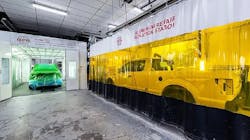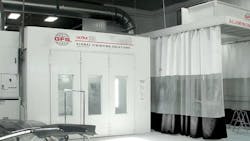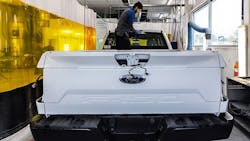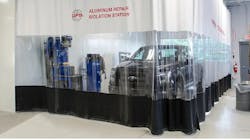Compared to repairs on conventional steel-bodied vehicles, aluminum repair work requires specialized equipment and additional training for technicians. This presents the possibility of new challenges for the collision repair industry, with more aluminum-bodied vehicles expected to enter the market as automakers try to meet the government’s fuel economy targets.
According to a study by P&L Consultants, less than one percent of nationwide collision repair work currently involves aluminum body vehicles. However, the Ford F-150, which has an aluminum body, is one of the best-selling vehicles in the U.S., and OEMs, such as Ford and GM, require rigorous certification to repair their aluminum body vehicles.
The density of aluminum-bodied vehicles in your area, and projections for the increased use of aluminum in vehicle bodies are factors to consider when deciding if you want to turn away aluminum repair business in the future. If your shop is considering adding aluminum repair to its operations, here are five things you need to know to protect your employees and keep your facility safe:
1. Aluminum repair requires a separate enclosure
Aluminum and steel do not mix. Should they come together during the repair process, the corrosion damage to the aluminum vehicle components could be irreversible. That is why a separate enclosure for aluminum repair is essential.
Aluminum Repair Stations from Global Finishing Solutions (GFS) feature heavy-duty, non-combustible curtain walls to prevent against contamination during the aluminum repair process. GFS offers three models to meet your budget requirements and application needs. The premium model, The Aluminum Repair Station Plus, also accommodates limited spraying, making it a versatile environment for aluminum repairs and spot painting.
2. Grinding and sanding dust can be explosive
The dust generated from grinding, sawing, cutting, sanding, and scratch brushing during aluminum repair has the potential to be explosive. In its certification program, Ford mandates the use of an immersion-type wet mix dust extraction system or pneumatic (air-operated) vacuum system dedicated to aluminum dust removal. Adequate personal protective equipment (PPE) should also be worn, typically a full body suit and breathing apparatus.
When performing aluminum repairs in an environment that also accommodates spraying, such as GFS’ Aluminum Repair Station Plus, technicians must take extra steps to clean and prep the environment to protect against explosions. The exhaust fans must be turned off, and exhaust filters must be covered in the Aluminum Repair Station Plus when performing aluminum repairs to limit airborne aluminum dust particles from collecting on the exhaust filters. After the floor is vacuumed, and the work area is cleaned, the covers can be removed from the filters, the fans can be turned on, and the vehicle can be primed in place.
“It’s as if the Aluminum Repair Station Plus is two different pieces of equipment,” GFS mechanical engineer Will McFadden said. “When you go from repair to finishing, you have to stop and clean the area and make sure there are not any aluminum grindings or dust laying around.”
3. Tools for steel repair cannot be used for aluminum repair
To avoid cross-contamination, separate sets of hand tools — ratchets, sockets, breaker bars, screwdrivers, pry bars, and wrenches — should be used for steel and aluminum repairs. If the same tools are used, they must be wiped clean after each use. Separate air/electric power tools and cutting tools for sanding and grinding are also usually required.
“You don’t want steel grindings to get on your aluminum truck body or they will corrode the truck body,” McFadden said.
4. Body shops need OEM certification to perform aluminum repair
Most OEMs require body shop technicians to undergo intensive Certified Collision Repair Facility (CCRF) training to receive certification as an authorized OEM repair facility for steel and aluminum body vehicles. OEMs such as Ford require I-CAR Gold Class designation. Continuing education is also a component of CCRF training, as well as recertification in welding, riveting, and structural repairs.
5. Metal forming is different for aluminum repair vs steel repair
Technicians repairing aluminum panels must have proper training to understand how the material moves when heated, as shaping aluminum is different than shaping sheet steel. Both aluminum and steel can be easily shaped or molded, but unlike steel, aluminum does not easily return to its original shape after being stretched or compressed.
Attempts to forcefully straighten aluminum — for instance, pushing out a dent — can cause stress in the material, leading to microfractures in the damaged areas. When repairing aluminum, heat application and more mechanical labor are often required for it to return to its original shape.
If panel straightening is involved, repairing an aluminum panel can take 20 to 40 percent longer than a steel panel. That is part of the reason why nationwide labor rates for aluminum repairs are two to four times higher than steel repairs.
Increased need for aluminum repair
In addition to considering the safety of your employees and facility, the decision on whether to incorporate aluminum repair into a shop’s operations is often based on a risk-reward assessment of the investment in equipment. Whether the shop thinks there is a high enough volume of aluminum repairs to turn a profit is another consideration.
Many luxury vehicles have aluminum bodies, including the Jaguar XE and XJ, Cadillac CT6, Chevrolet Corvette and BMW i8. As more high-volume vehicles, such as the Ford F-150, are converted from steel to aluminum bodies, collision repair facilities can expect an increased need for aluminum repair in the coming years. This will require technicians to become skilled at using new tools and equipment, in addition to new procedures and environments for aluminum repair.





